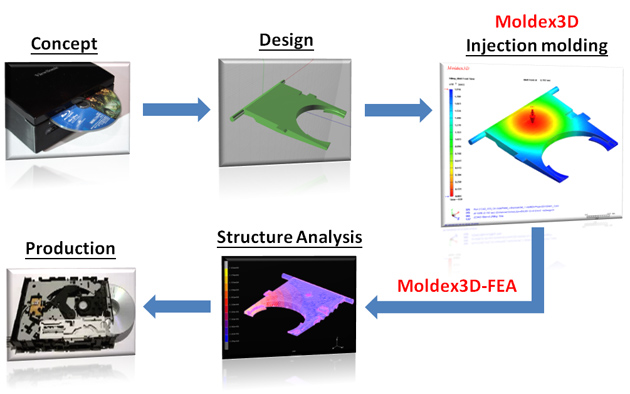Plastics are ingrained in our everyday lives, ranging from electronics, automotive components to special applications in medical devices, optical lens…etc. But as plastics become more embedded in our daily lives, we are becoming more demanding about how to increase strength and durability of plastic products and how to reduce weight of products to meet environmental requirements. The earliest known composite material can be traced back to 6,000 years ago, human already learned to build stronger construction by combining straw and mud. After thousand years of evolution, reinforced plastics were developed during World War II by adding glass fiber to plastic resin matrix.. Today, reinforced plastics are widely used in many fields to enhance the strength of products, and recently have replaced metals with relatively lower cost and weight in applications such as the outer bodies of electronics, car hoods, aerospace industry, etc
In addition to adding synthetic fiber to plastics, microcellular foaming process can also achieve weight reduction. Microcellular foaming process is about blending gas with polymer melt to develop microcellular foam structure to achieve weight reduction and material savings.
Product life cycle management is becoming indispensible in the process of developing new products, covering marketing research, design, analysis, mass production. More importantly, the analysis before the actual manufacturing can determine the success of a new product. Â For example, the analysis of injection molding products includes molding process analysis and structural analysis. Traditional CAE analyses do not consider the molding properties influence on structural analysis and therefore ignore the process-induced effects on products. Â On the other hand, mold design and process parameters determine the microstructure distribution of the products made with fiber reinforced plastics or microcellular foaming. For instance, gate locations and injection velocity will affect the distribution and orientation of fibers; gate locations and counter pressure will influence the distribution and density of microcellular foaming. If these effects on microstructure are not taken into consideration, it is impossible to make accurate predictions and therefore fail to achieve the purpose of product life cycle management.

Take the case of CD-ROM drive bearing fixed part for example (Fig.1); the counter pressure on both ends of the product should be taken into account to control inserting and ejecting discs. The height difference between A and B should not exceed more than 1 mm (see Fig. 2); otherwise it may cause damage on the disc. Molding analysis and structural analysis were conducted with different filling times to demonstrate the process-induced effects on products. Fig. 3 shows the fiber orientation distribution of Moldex3D analysis, and the levels from blue to red represent the degree of fiber alignment, from disordered alignment to full alignment. Moreover, it shows that the shorter the filling time is, the higher the degree of fiber orientation distribution will be and so does the microstructure. The following information can be obtained through using Moldex3D FEA module for a more realistic prediction of structural analysis.
1. Mesh information: reflecting the Moldex3D analysis result on the mesh types of different structural software.
2. Material information: providing material properties of Moldex3D analysis to structural analysis software.
3. Fiber orientation information: providing non-homogeneous micro structural properties calculations to Digimat.
 Fig. 1 Â Product lifecycle management of CD-ROM drive bearing fixed part.
Fig. 1 Â Product lifecycle management of CD-ROM drive bearing fixed part.
 Fig. 2 Â Force and specification restriction of bearing fixed part.
Fig. 2 Â Force and specification restriction of bearing fixed part.
A complete analysis flow can be done through transferring above information. Fig. 4 shows the result of the structure analysis of the CD-ROM drive bearing fixed part with different filling times. The result suggests that process has a significant impact on product quality, and they are nonlinear, which means that injection speed will not affect product quality. It is found that the products with medium filling time (0.2 second) and with low filling time (1.0 second) both meet the product specification. However, the medium filling time has lower residual stress which makes it the best process parameter.
The concept of product lifecycle management has been implemented for several years, and it has been adopted by many industry companies. It is important to take the effects of material variation induced by molding processes on plastic products into consideration. And it can only been achieved with the integration of Moldex3D molding simulation and structural analysis to obtain realistic predictions of the product behaviors before actual manufacturing, which can enhance competitiveness with development cost reduction and faster time-to-market.
 Fig. 3 Â Fiber orientation distribution with different filling times.
Fig. 3 Â Fiber orientation distribution with different filling times.
 Fig. 4 Â The result of structural analysis with different filling times.
Fig. 4 Â The result of structural analysis with different filling times.
Drive Rollers,Potato Harvester Accessories Rollers,Tomato Harvester Accessories Rollers,Sugar Beet Harvester Accessories Rollers
Hebei Huichao Machinery Parts CO., Ltd. , https://www.huichaoagparts.com